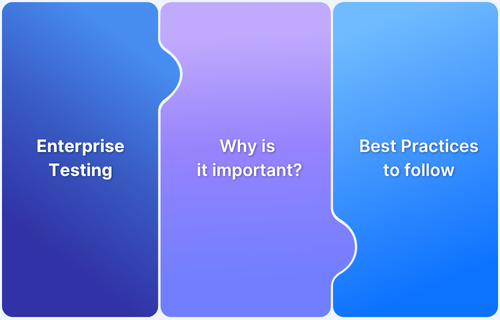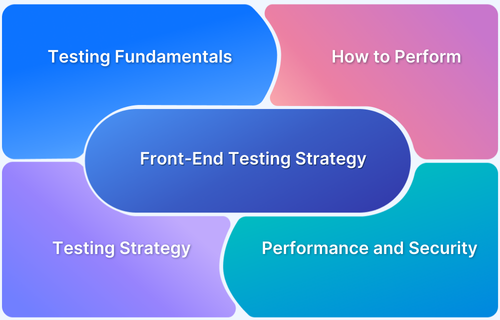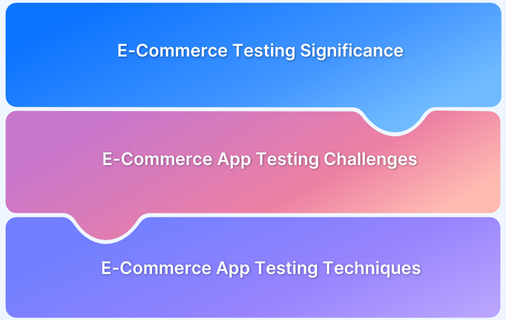Development teams often face slow test execution, frequent test failures, and challenges in maintaining large test suites, leading to delays and higher costs.
The Test Automation Pyramid addresses these issues by guiding teams to strategically prioritize test layers, ensuring a balanced approach to automation that improves speed, reliability, and cost-efficiency.
Overview
The Test Automation Pyramid is a strategy that helps optimize the efficiency of automated testing by balancing the number of tests at each layer.
Three Layers of the Test Automation Pyramid:
- Unit Tests (Base Layer): These are the foundation of the pyramid, focusing on testing individual units of code in isolation. They are fast, reliable, and easy to maintain.
- Integration Tests (Middle Layer): These tests verify the interaction between different components or services, ensuring that they work together as expected.
- UI/End-to-End Tests (Top Layer): These are high-level tests that simulate real user interactions, checking the overall functionality and user experience.
Benefits of Using the Test Automation Pyramid:
- Faster Test Execution: Prioritizing unit tests at the base ensures quick feedback, speeding up the development cycle.
- Reduced Maintenance Costs: Fewer high-maintenance tests at the top mean less time spent on debugging and maintaining flaky tests.
- Better Test Coverage: A balanced approach ensures comprehensive coverage at all levels without overloading the top layer.
- More Reliable Tests: Focusing on lower-level tests ensures more stable and reliable results, reducing the chances of failures in production.
This article explores the Test Automation Pyramid, its levels, and how Agile teams can implement it to improve testing efficiency and reliability.
What is a Test Automation Pyramid?
The Test Automation Pyramid is a strategic framework that helps optimize automated testing by focusing on the distribution of test types across different layers. It emphasizes having a large number of fast, low-cost unit tests at the base, a moderate number of integration tests in the middle, and fewer high-cost, slow end-to-end tests at the top.
This balanced approach ensures faster feedback, improved test coverage, and reduced maintenance overhead, leading to more efficient and reliable testing practices.
The different levels of a Test Automation Pyramid
The Test Automation Pyramid consists of three distinct levels, each serving a unique purpose in ensuring comprehensive test coverage and efficient automation.
Below are the details of each level:
Level 1 – Unit Tests
Unit tests form the foundation of the Test Automation Pyramid. They focus on testing individual components or functionalities of the software in isolation. Unit tests are designed to verify that each unit of code functions as expected under different conditions, including happy path scenarios, edge cases, and error handling.
Key Characteristics:
- Fast and lightweight tests.
- Run frequently, ideally on every code change.
- Provide immediate feedback to developers.
- Primarily focus on individual code units (e.g., functions, methods).
- Crucial for maintaining high code quality and ensuring early detection of issues.
Unit tests are the most numerous layer, and it is vital to keep them fast and reliable. This helps maintain a robust testing pipeline, where developers can quickly verify that their individual code changes do not introduce errors.
Level 2 – Integration Tests
While unit tests ensure the correctness of individual components, integration tests validate how these components work together as a system. These tests focus on verifying the interactions between different modules, databases, and external services (e.g., APIs), ensuring that the system functions correctly as a whole.
Key Characteristics:
- Slower than unit tests due to interaction with external services.
- Test interactions between different parts of the application (e.g., database calls, API requests).
- Require a preproduction or staging environment for execution.
- Less frequent than unit tests but essential for catching integration issues.
Integration tests are essential for identifying issues related to data flow, external dependencies, or improper communication between components. They often highlight problems that would not be detected by unit tests, such as issues with databases, third-party services, or the integration of new features into the existing codebase.
Level 3 – End-to-End Tests
End-to-end (E2E) tests are the final level of the Test Automation Pyramid. These tests simulate real user interactions, testing the application as a whole from start to finish. E2E tests ensure that all features work together as expected in a production-like environment, validating the overall functionality and user experience.
Key Characteristics:
- Slowest and most resource-intensive tests.
- Simulate real-world user behavior and interactions.
- Test the full application, including external dependencies (e.g., databases, third-party services).
- Run less frequently due to their high cost in time and resources.
- Provide confidence in the overall user experience and application performance.
End-to-end tests are crucial for verifying that the application meets its functional requirements from the perspective of the user. They typically involve actions like logging in, browsing a website, making transactions, and other high-level use cases.
Because of their complexity and interaction with multiple systems, E2E tests are more fragile and prone to failure, requiring stable environments and careful management of dependencies.
Why should Agile Teams use the Test Automation Pyramid?
Agile teams thrive on delivering high-quality software quickly and iteratively. However, as the pace of development increases, the challenge of maintaining effective and efficient testing also grows.
The Test Automation Pyramid offers a structured approach to testing that aligns perfectly with Agile methodologies, ensuring that teams can balance speed, quality, and cost-effectiveness in their automated testing efforts.
- Faster Feedback Loops: Prioritizing unit tests at the base provides quick feedback to developers, allowing issues to be detected and fixed early in the development cycle.
- Scalability and Maintainability: The Test Automation Pyramid promotes scalable and maintainable test suites, ensuring that as features grow, the test suite remains manageable without becoming burdensome.
- Cost-Effective Testing: Fewer end-to-end tests reduce maintenance costs while unit and integration tests catch issues earlier, preventing costly defects in production.
- Quality Assurance at Every Level: It ensures comprehensive coverage across all layers; unit tests for individual components, integration tests for system interactions, and end-to-end tests for user experience.
- Alignment with Agile Principles: Supports continuous integration, iterative development, and frequent releases, enabling teams to adapt quickly to changes without sacrificing quality.
- Reduced Test Flakiness: By focusing on unit and integration tests, Agile teams minimize the fragility and instability often associated with end-to-end tests, ensuring more reliable results.
How to Implement the Test Pyramid in Your Workflow
To effectively implement the Test Automation Pyramid in your workflow, follow these key steps to ensure a balanced, efficient, and scalable testing strategy:
- Start with Unit Tests: Begin by creating a solid base of unit tests to cover individual components and ensure quick feedback for developers.
- Add Integration Tests: Next, implement integration tests to validate how different parts of your system work together, especially focusing on interactions with external services.
- Limit End-to-End Tests: Use end-to-end tests for critical user flows only, ensuring that your application works as expected in real-world scenarios.
- Integrate into CI/CD Pipeline: Automate your tests within a continuous integration pipeline to run tests automatically with each code change.
- Balance Test Levels: Ensure a larger number of unit tests, a moderate amount of integration tests, and fewer end-to-end tests, maintaining a well-balanced pyramid.
- Review and Refactor Regularly: Continuously monitor your tests for coverage, reliability, and efficiency, and refactor as the project evolves.
This structured approach will ensure that your team applies the Test Automation Pyramid effectively within the workflow.
Challenges in Applying the Software Testing Pyramid
Applying the Test Automation Pyramid in practice comes with several challenges that teams must address to ensure its effectiveness. Here are some of the common hurdles:
- Balancing Test Coverage: Struggling to find the right balance between unit, integration, and end-to-end tests, leading to gaps or redundancy in test coverage.
- Test Maintenance: Keeping tests up to date with evolving code and external dependencies can be time-consuming and challenging.
- Stable Test Environments: Setting up and maintaining complex test environments with dependencies like databases and third-party services for integration and end-to-end tests.
- Speed vs. Thoroughness: Managing the trade-off between quick-running unit tests and resource-intensive end-to-end tests without compromising on coverage.
- Test Flakiness: End-to-end tests are prone to flakiness due to external dependencies, leading to unreliable test results.
- Skill Gaps: Teams may lack the necessary expertise in test design or automation tools, affecting the effectiveness of the pyramid.
- Cost of Automation Tools: Running automated tests across multiple layers requires infrastructure and tools, which may incur additional costs.
- Overuse of End-to-End Tests: Teams may be tempted to over-rely on end-to-end tests, slowing down the testing process and increasing maintenance effort.
How BrowserStack helps with the Test Automation Pyramid
BrowserStack provides powerful tools and infrastructure that help streamline the implementation of the Test Automation Pyramid, offering support across all levels of testing. Here’s how:
- Supports Unit Testing: BrowserStack’s cloud infrastructure enables teams to run unit tests across various browsers and devices, ensuring that individual components function as expected in different environments.
- Enhances Integration Testing: With access to real devices and browsers, BrowserStack makes it easier to run integration tests, ensuring that different system components interact smoothly, even when connected to external services and databases.
- Boosts End-to-End Testing: BrowserStack helps teams run end-to-end tests on real devices, simulating user interactions across browsers and platforms. This ensures that the entire application works as intended from a user’s perspective.
- CI/CD Integration: BrowserStack integrates seamlessly with CI/CD tools, allowing automated tests to run continuously and providing quick feedback at every level of the Test Automation Pyramid.
- Reduces Flakiness: By offering stable, real-device testing environments, BrowserStack minimizes the risk of flaky tests, especially in end-to-end testing, ensuring more reliable results.
Conclusion
The Test Automation Pyramid is a proven strategy to optimize the efficiency, speed, and reliability of automated testing by balancing the distribution of tests across unit, integration, and end-to-end levels.
By focusing on a solid foundation of unit tests, followed by integration tests and a limited number of end-to-end tests, teams can ensure comprehensive test coverage while maintaining fast feedback loops and minimizing maintenance overhead.
BrowserStack helps implement this pyramid effectively by providing cloud-based infrastructure, real-device testing, and seamless integration with CI/CD pipelines. With BrowserStack Automate, teams can execute tests across multiple browsers and devices, streamline their testing process, and deliver high-quality software faster.
By leveraging BrowserStack, you can enhance your test automation strategy, reduce flakiness, and ensure reliable test results at every layer of the Test Automation Pyramid.







